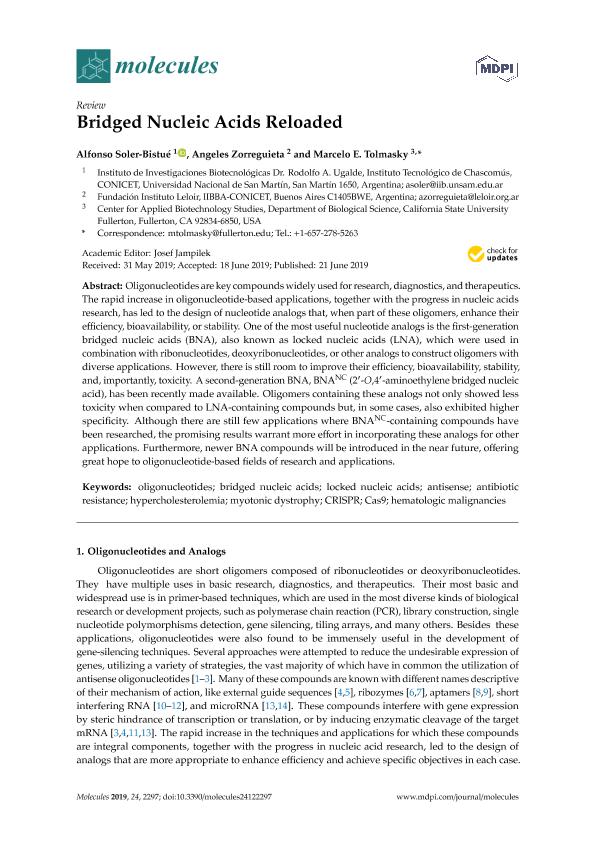Mostrar el registro sencillo del ítem
dc.contributor.author
Soler Bistue, Alfonso J. C.

dc.contributor.author
Zorreguieta, Ángeles

dc.contributor.author
Tolmasky, Marcelo E.

dc.date.available
2022-02-04T18:44:08Z
dc.date.issued
2019-06
dc.identifier.citation
Soler Bistue, Alfonso J. C.; Zorreguieta, Ángeles; Tolmasky, Marcelo E.; Bridged nucleic acids reloaded; Molecular Diversity Preservation International; Molecules; 24; 12; 6-2019; 1-17
dc.identifier.issn
1420-3049
dc.identifier.uri
http://hdl.handle.net/11336/151385
dc.description.abstract
Oligonucleotides are key compounds widely used for research, diagnostics, and therapeutics. The rapid increase in oligonucleotide-based applications, together with the progress in nucleic acids research, has led to the design of nucleotide analogs that, when part of these oligomers, enhance their efficiency, bioavailability, or stability. One of the most useful nucleotide analogs is the first-generation bridged nucleic acids (BNA), also known as locked nucleic acids (LNA), which were used in combination with ribonucleotides, deoxyribonucleotides, or other analogs to construct oligomers with diverse applications. However, there is still room to improve their efficiency, bioavailability, stability, and, importantly, toxicity. A second-generation BNA, BNANC (20 -O,40 -aminoethylene bridged nucleic acid), has been recently made available. Oligomers containing these analogs not only showed less toxicity when compared to LNA-containing compounds but, in some cases, also exhibited higher specificity. Although there are still few applications where BNANC-containing compounds have been researched, the promising results warrant more effort in incorporating these analogs for other applications. Furthermore, newer BNA compounds will be introduced in the near future, offering great hope to oligonucleotide-based fields of research and applications.
dc.format
application/pdf
dc.language.iso
eng
dc.publisher
Molecular Diversity Preservation International

dc.rights
info:eu-repo/semantics/openAccess
dc.rights.uri
https://creativecommons.org/licenses/by/2.5/ar/
dc.subject
ANTIBIOTIC RESISTANCE
dc.subject
ANTISENSE
dc.subject
BRIDGED NUCLEIC ACIDS
dc.subject
CAS9
dc.subject
CRISPR
dc.subject
HEMATOLOGIC MALIGNANCIES
dc.subject
HYPERCHOLESTEROLEMIA
dc.subject
LOCKED NUCLEIC ACIDS
dc.subject
MYOTONIC DYSTROPHY
dc.subject
OLIGONUCLEOTIDES
dc.subject.classification
Bioquímica y Biología Molecular

dc.subject.classification
Ciencias Biológicas

dc.subject.classification
CIENCIAS NATURALES Y EXACTAS

dc.title
Bridged nucleic acids reloaded
dc.type
info:eu-repo/semantics/article
dc.type
info:ar-repo/semantics/artículo
dc.type
info:eu-repo/semantics/publishedVersion
dc.date.updated
2020-11-20T18:10:09Z
dc.journal.volume
24
dc.journal.number
12
dc.journal.pagination
1-17
dc.journal.pais
Suiza

dc.journal.ciudad
Basel
dc.description.fil
Fil: Soler Bistue, Alfonso J. C.. Universidad Nacional de San Martín. Instituto de Investigaciones Biotecnológicas. - Consejo Nacional de Investigaciones Científicas y Técnicas. Oficina de Coordinación Administrativa Parque Centenario. Instituto de Investigaciones Biotecnológicas; Argentina
dc.description.fil
Fil: Zorreguieta, Ángeles. Consejo Nacional de Investigaciones Científicas y Técnicas. Oficina de Coordinación Administrativa Parque Centenario. Instituto de Investigaciones Bioquímicas de Buenos Aires. Fundación Instituto Leloir. Instituto de Investigaciones Bioquímicas de Buenos Aires; Argentina
dc.description.fil
Fil: Tolmasky, Marcelo E.. California State University; Estados Unidos
dc.journal.title
Molecules

dc.relation.alternativeid
info:eu-repo/semantics/altIdentifier/url/https://www.mdpi.com/1420-3049/24/12/2297
dc.relation.alternativeid
info:eu-repo/semantics/altIdentifier/doi/http://dx.doi.org/10.3390/molecules24122297
Archivos asociados
